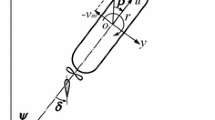Abstract
The blended wing body (BWB) aircraft as a novel aircraft configuration has a poor longitudinal static stability. A V-tail is installed on the BWB to improve the longitudinal static stability, which achieves the limited improvements. Therefore, the BWB is investigated to further improve the longitudinal static stability with experimental tests and numerical simulations in this paper. The variation with angle of attack (AOA) α of the pitching moment coefficient (Cm) is divided into three regions, i.e., the first AOA region with static stability, the AOA region with static instability, and the second AOA region with static stability. It is found that the position of the forebody vortex acting on the V-tail surface is closely related to the longitudinal static stability of the BWB aircraft. Through increasing the spanwise distance of the V-tail to change the position of the forebody vortex acting on the V-tail surface, the AOA region with static instability is decreased. The longitudinal static stability of the BWB aircraft is improved. The evolution of associated pressure distributions, flow separations and vortical structures is presented in detail.












Similar content being viewed by others
Availability of data
The data that support the findings of this study are available from the corresponding author upon reasonable request.
Abbreviations
- α :
-
Angle of attack (AOA)
- C m :
-
Pitching moment coefficient
- ω x*:
-
Dimensionless vorticity
- ρ ∞ :
-
Mass density of air
- S :
-
Cross-sectional area of the aircraft
- D :
-
Distance between the tail end of the aircraft and the moment center of the balance
- C p :
-
Pressure coefficient
- M :
-
Pitching moment of the BWB aircraft
- b a :
-
Mean aerodynamic chord (MAC)
- V ∞ :
-
Freestream velocity
- Re :
-
Reynolds number based on ba and V∞
- b :
-
Spanwise distance of the V-tail
- L :
-
Spanwise size of the test model
References
Potsdam, M.A., Page, M.A., Liebeck, R.H.: Blended wing body analysis and design [R]. In: Proceedings of the 15th Applied Aerodynamics Conference, 23 June–25 June, 1997, Atlanta, GA, U.S.A., AIAA-97-2317
Wang, J., Zheng, X.M.: Configuration optimization design of blended wing body unmanned aerial vehicle. Adv. Aeronaut. Sci. Eng. 4, 442–446 (2015)
Smith, H.: College of aeronautics blended wing body development programme. International Council of the Aeronautical Sciences, 2000 Conference, ICAS Paper 1.1.4 (2000)
Bolsunovsky, A.L., Buzoverya, N.P., Gurevich, B.I., Denisov, V.E., et al.: Flying wing-problems and decisions. Aircr. Des. 4, 193–219 (2001)
Roman, D., Alien, J.B., Liebeck, R.H.: Aerodynamic design challenges of the blended-wing-body subsonic transport [R]. In: Proceedings of the 18th Applied Aerodynamics Conference, 14 August–17 August, 2000, Denver, CO, U.S.A., AIAA-2000-4335
Liebeck, R.H.: Design of the blended-wing-body subsonic transport. J. Aircr. 41(1), 10–15 (2004)
Wakayama, S., Kroo I.: The challenge and promise of blended-wing-body optimization [R]. In: 7th AIAA/USAF/NASA/ISSMO Symposium on Multidisciplinary Analysis and Optimization, 2 September–4 September, 1998, St. Louis, MO, U.S.A. AIAA-98-4736
Qin, N., Vavalle, A., Moigne, A.L., Laban, M.: Aerodynamic considerations of blended wing body aircraft. Prog. Aerosp. Sci. 40(2004), 321–343 (2004)
Mukhopadhyay, V., Sobieszczanski-Sobieski, J., Kosaka, I., Quinn, G., Charpentier, C.: Analysis design and optimization of non-cylindrical fuselage for blended-wing-body (BWB) vehicle [R]. In: 9th AIAA/ISSMO Symposium on Multidisciplinary Analysis and Optimization, 4 September-6 September, 2002, Atlanta, Georgia, AIAA-2002-5664
Ma, S.H., Wu, C.F., Chen, H.M.: Study on stability and manoeuvrability of flying wing aircraft. Flight Dyn. 24(3), 17–21 (2006)
Dong, Y.T., Wang, Z.P.: Aerodynamic stability augmentation at longitudinal high AOA of flying wing aircraft during taking-off and landing. Flight Dyn. 34(1), 31–35 (2016)
Rizal, E.M.N., Wahyu, K., Wirachman, W. Zurriati, M.A.: Static stability of baseline-II blended wing body aircraft at low subsonic speed: investigation via computational fluid dynamics simulation [R]. In: Proceedings of the 2010 International Conference on Science and Social Research, 5 December–7 December, 2010, Kuala Lumpur, Malaysia
Sami, A., Clément, L., Jean-Yves, T.: Conceptual design, performance and stability analysis of a 200 passengers blended wing body aircraft. Aerosp. Sci. Technol. 71, 325–336 (2017)
Rizal, E.M.N., Wahyu, K., Wirachman, W.: Aerodynamic, stability and flying quality evaluation on a small blended wing-body aircraft with canard foreplanes. Proced. Technol. 15, 783–791 (2014)
Tang, Y.Z., Wang, X.S.: Investigation on the improvement of stabilities of combat aircraft with strake wing configuration. Flight Dyn. 20(2), 55–57 (2002)
Jiang, J., Zhong, B.W., Fu, S.: Influence of overall configuration parameters on aerodynamic characteristics of a blended-wing-body aircraft. Chin. J. Aeronaut. 37(1), 278–289 (2016)
Zadeh, P.M., Sayadi, M.: An efficient aerodynamic shape optimization of blended wing body UAV using multi-fidelity models. Chin. J. Aeronaut. 31(6), 1165–1180 (2018)
Siouris, S., Qin, N.: Study of the effects of wing sweep on the aerodynamic performance of a blended wing body aircraft. J. Aerosp. Eng. 221, 47–55 (2007)
Li, J.P., Wang, H.P., Ge, W.J.: Low speed reflexed airfoil robust optimization design for flying wing configuration. Flight Dyn. 29(1), 17–20 (2011)
Panagiotou, P., Fotiadis-Karras, S., Yakinthos, K.: Conceptual design of a blended wing body MALE UAV. Aerosp. Sci. Technol. 73, 32–47 (2018)
Menter, F.R: Zonal two equation κ-ω turbulence models for aerodynamic flow [R]. In: Proceedings of the 23rd Fluid Dynamics, Plasma dynamics, and Lasers Conference, 6 July–9 July, 1993, Orlando, Florida, U.S.A., AIAA-1993-2906
Acknowledgements
The study is supported by the National Natural Science Foundation of China (12002022 & 11972060); Ningbo National Science Foundation (202003N4177) and the Research Fund of Key Laboratory of Unsteady Aerodynamics and Flow Control (KLUAFC-E-201902).
Author information
Authors and Affiliations
Corresponding author
Additional information
Publisher's Note
Springer Nature remains neutral with regard to jurisdictional claims in published maps and institutional affiliations.
Rights and permissions
About this article
Cite this article
Qi, Z., Zong, S. & Wang, Y. Investigation on improving longitudinal static stability of a blended wing body aircraft. CEAS Aeronaut J 12, 755–766 (2021). https://doi.org/10.1007/s13272-021-00538-2
Received:
Revised:
Accepted:
Published:
Issue Date:
DOI: https://doi.org/10.1007/s13272-021-00538-2




